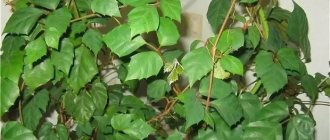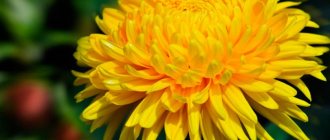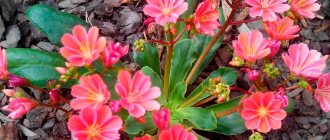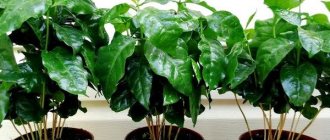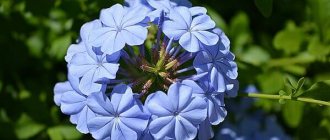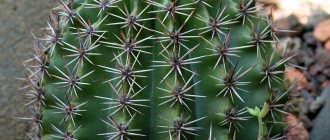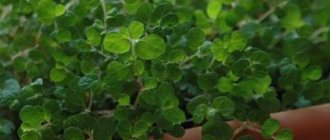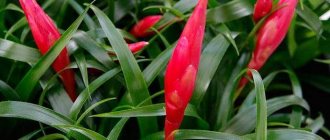Rhoicissus is a fast-growing herbaceous perennial of the grape family with climbing or creeping shoots that in natural conditions can reach a length of 3 meters or more.
Rhoicissus is native to the tropics of Central and Southern Africa. In indoor floriculture, the plant is grown as a hanging plant; its stems, without pruning, stretch up to 1.5 meters in length. The leaves of roisissus are quite large, painted in rich shades of green, and can have different shapes depending on the variety (grape, rounded, palmate, etc.).
The flowering of rhoicissus is not particularly remarkable; it happens only in natural conditions: in summer, short flower stalks with umbrella inflorescences, uniting many very small greenish flowers, appear on the bushes of the plant from the axils of the leaves.
Also be sure to check out how to grow Cissus and Tetrastigma Voignier plants.
| High growth rate. |
| Almost does not bloom indoors. |
| An easy plant to grow. |
| Perennial. |
Roicissus: care at home. Briefly
Roicissus Rhombicus. Photo
| Temperature | About +21°C during the period of active growth, about +15°C, but not lower than +10°C in winter. |
| Air humidity | Moderate, can be grown at low humidity with additional spraying. |
| Lighting | Bright diffused with shading from the midday sun. Roiscissus can grow in partial shade. |
| Watering | Moderate with short intervals of soil drying: in summer - once every 3-4 days, in winter - 2-3 times a month. |
| Soil for rhoicissus | Purchased nutritious and loose or prepared independently from garden, turf and leaf soil with the addition of sand (perlite) in a ratio of 1:1:1:0.5. |
| Feeding and fertilizer | During active growth, apply a liquid complex composition for indoor plants once every 2 weeks. |
| Rhoicissus transplant | As the bush grows: young plants are replanted 1-2 times a year, adults - once a year, old ones only need to renew the top layer of soil. |
| Reproduction | By apical cuttings, parts of stems or dividing a bush. |
| Features of cultivation | Roicissus at home periodically needs to be bathed in a warm shower to remove dust and dirt from the leaves. In the warm season, the plant can be kept on the balcony or in the garden, shaded from the midday sun. In order for the roiscissus bush to be lush and have a neat shape, you should regularly pinch the tops of elongated shoots. |
Birch - a houseplant similar to a birch tree
In many offices, schools and simply huge public spaces you can find a kind of flower that curls along the wall or, thanks to its stand, resembles a tree. People call this specimen a birch tree.
Appearance of indoor birch tree
Birch is a home plant that fits perfectly into any interior and helps to harmonize the space and make it more alive. Thanks to pruning, you can create any shape and size.
Without treatments, the length of the moon-shaped trunk can reach 1.5-2 m in length. A flower similar to a birch tree is loved by many gardeners precisely for its ease of care and growth rate.
What is the correct name for a houseplant that looks like a birch tree? Birch is an indoor flower, it is grown for its beauty and many do not think about the scientific name of the plant. However, the home flower has an exact name, which not many people know, much less use in everyday life. Depending on the specific species, this is cissus or rhoicissus.
Appearance of indoor birch tree
There are several varieties of the plant. The most popular is rhombicus rhombus, which has a complex leaf structure and is most adapted to growing at home.
What does a birch tree look like?
The home flower birch belongs to plants of the grape family. This classification is determined by external features:
- the trunk curls or is a vine;
- the crown turns green all year round;
- shoots can grow from 60 cm to several meters;
- the leaf can have any color - from dark green to light green.
Plant in interior design
Additional Information ! Thanks to pruning, you can form a suitable crown. In the absence of such care, the domestic birch tree will grow like wild grapes in all directions.
Caring for roisissus at home. Details
Rhoicissus flowering
The rhoicissus plant blooms extremely rarely at home. In nature, flowering usually occurs at the beginning of summer: at this time, inconspicuous small flowers of a greenish tint appear from the axils of the leaves, collected in umbrella inflorescences on short petioles.
Temperature
In the warm season, the plant is kept at a temperature close to room temperature (+18-+22°C); for the winter, the flower pot is moved to a cooler room with an air temperature of about +15°C (but not lower than +10°C).
Spraying
Homemade roisissus can grow actively at low humidity and tolerates the dry air of city apartments well. However, the plant responds well to regular spraying: its foliage acquires a more saturated green hue, the procedure also helps to avoid drying out of the tips of the leaf blades.
Spray roisissus 2 times a week with warm, settled water.
Lighting
Roicissus does not need intense and prolonged lighting; it grows well in fairly bright, but diffused light or in partial shade. It is best to place a flower pot on a south, east or west window, shading it from active midday rays.
Watering
During the period of active growth, the roisissus should be watered very generously, but between waterings the soil should be allowed to dry slightly (to a depth of 1-2 cm). Water should be taken at room temperature. With the onset of cold weather, the frequency of watering is reduced to a minimum, but the earthen clod must not be allowed to dry out, otherwise the plant will shed its leaves.
Roisissus pot
The container for growing the plant must be spacious and stable, and it will have to be changed quite often, since the roiscissus grows very quickly. When the diameter of the pot reaches 30 cm, the plant can no longer be replanted, but only annually update the top layer of soil.
Priming
The plant does not have any special requirements for soil quality; any loose commercial soil enriched with nutrients is perfect for it. The soil mixture for roisissus can be prepared at home from leaf, turf and garden soil with the addition of river sand or perlite (the ratio of ingredients is 1: 1: 1: 0.5).
Feeding and fertilizer
Due to the fact that roisissus grows very actively at home, it quickly takes all nutrients from the soil, so their reserves should be replenished regularly. Fertilizing is carried out every 2 weeks with any liquid complex fertilizer for indoor plants. Roicissus also responds well to organic feeding.
Transfer
Due to the very active growth of bushes during the growing season, young plants must be replanted at least 1-2 times a year.
Adult specimens need to change the pot to a new larger one every year. Transplanting rhoicissus that has reached a very mature age is, as a rule, extremely difficult due to the large size of the plant, so it is enough to only renew the top layer of soil in an old pot to a depth of 3 cm once a year.
Trimming
To prevent the roisissus bush from growing over time and losing its decorative value, it should be regularly trimmed, during which the tops of elongated shoots are pinched, and stems that stick out to the sides and spoil the appearance of the bush are removed.
The cut parts take root easily and new plants can be obtained from them.
Rest period
Caring for rhoicissus at home also involves properly organizing a rest period for the plant. With the arrival of winter, when daylight hours are significantly reduced, the pot with the flower is transferred to a cool room with an air temperature of about +15°C, it is watered rarely and very moderately to prevent rotting of the roots, and feeding is temporarily suspended.
Possible problems in growing birch trees
It is easy to determine why certain metamorphoses occur with roisissus, since the plant reacts to changes in the microclimate of the room.
What diseases and parasites can affect a flower:
- Lack of humidity often leads to the appearance of fungal diseases that can affect the above-ground and underground parts of the specimen.
- Poorly disinfected soil can become the basis for the appearance of scale insects and dust mites.
- If the leaves begin to dry, then infection with root rot is possible. This problem occurs if the substrate does not allow air to pass through, there is no drainage and excess water stagnates in the pot.
- A frequent “guest” is powdery mildew. But the disease can only affect plants that are weakened after a sharp temperature change.
Diseases of indoor birch
Crohn's can be treated with a soap solution against any type of parasites and infections, but if the form of the disease is not advanced. If this does not help, then special means must be used to combat the disease.
The decorative version of roisissus is an ideal option for breeding by inexperienced gardeners who want to decorate their home with a floral arrangement. An ideal option for such a plant would be a house with “tropical” climate conditions. The plant does not require special care; it reproduces using the elementary method.
Diseases and parasites
Caring for a birch tree at home is not difficult, but if you do not follow the listed rules, this will lead to the flower starting to hurt or various pests appearing. Despite the fact that this crop is unpretentious, it can suffer from various diseases and parasites.
An example is the spider mite . It appears on a birch tree and begins to parasitize only if the flower was not properly cared for, for example, when watering was irregular and rather meager. As a result, the finest cobwebs gradually appear on the branches and leaves. To combat this pest, it is recommended to use insecticidal preparations. In addition, all rules must be followed.
Scale insects also attack indoor plants because care rules are not followed. But the plant will quickly recover after special treatment, regular watering and loosening of the soil.
Aphids can also damage a birch tree . They get rid of it using different methods. For example, you can use special preparations for spraying bushes. A soap solution is also suitable (use only laundry soap), to which a small amount of ordinary wood ash is added.
One of the diseases is root rot , which develops due to improper care. The plant gradually withers, withers, and leaves fall off. In this case, you need to carefully remove the shrub from the container, cut off the diseased roots, treat them with ash or charcoal, and then transplant them into a new container. Be sure to fill it with fresh soil.
This is interesting: How to deal with diseases and pests in Fuchsia at home
Another dangerous disease is powdery mildew . It appears on birch foliage in the form of a whitish coating. Gradually the bush fades. To combat this disease, it is recommended to use the special drug “Topaz”.
Most often, the leaves of the birch tree begin to dry out and fall off. This is due to a number of factors:
- Excessively dry air. This can be corrected by frequently spraying the flower with a spray bottle.
- Root rotting. In this case, the plant must be replanted.
- Seasonality. Leaves may fall off in autumn.
- Draft.
- Lack of oxygen to roots. This is due to the fact that the soil is excessively dense. In this case, it should be loosened the next day after watering.
If you have not yet decided which flower to keep at home, then this is, of course, roisissus, because it will decorate any wall. In addition, it is completely unpretentious, so it does not require special care. But you shouldn’t believe in various signs, as this plant will only decorate your home!
Diseases and pests
Roicissus is not capricious at all, it gets sick extremely rarely, but some deterioration in the appearance of the plant can be caused by errors in caring for it, including:
- Brown spots appear on the leaves of the roisissus - this is sunburn. The plant needs to be shaded during especially hot hours from direct sunlight.
- The shoots stretch out and the leaves become smaller - the plant does not have enough light, you need to move the pot with it to a more illuminated place.
- Rhoicissus leaves turn yellow if the watering regime is disrupted or the soil's nutritional reserves are depleted. The plant should be watered regularly and moderately and fed in a timely manner.
- The tips of the leaves dry out due to too low air humidity. The problem can be solved by regularly spraying the foliage.
Pests that pose a real danger to roiscissus include spider mites, mealybugs, aphids and whiteflies; they are controlled with special insecticidal preparations.
Where is the best place to place the cissus?
- If quarrels often break out in the family, and it is difficult for household members to listen and understand each other, the birch tree should be placed in the room where all family members usually spend their free time, for example, in the living room or kitchen.
- A pot of cissus in a schoolchild or student’s room will help him quickly absorb large amounts of material being studied.
- People associated with art are advised to keep a birch tree near their desk or other place where they are creative. The plant will provide an influx of fresh ideas and creative thoughts.
- If someone in the house is sick, you should keep a pot of cissus in the sick person’s room. The plant will take away negative energy and help the person recover faster.
Indoor birch is an interesting and unpretentious plant that can decorate any home with its presence. As for beliefs and signs, each person decides for himself whether to take them into account or not. But still, it is better for overly superstitious people to refuse to keep flowers in the house, the properties of which are said not only to be good. Otherwise, instead of pleasant communication with a green friend, only fears and anticipation of negative events await.
Types of rhoicissus domestica with photos and names
Rhoicissus digitata
A highly decorative variety with unusual palmate leaves, the surface of which is glossy, leathery, and painted in a very rich emerald green hue. The reverse side of the leaf blade is covered with thin reddish fibers. In nature it blooms with inconspicuous greenish-yellow flowers.
Rhoicissus rhomboidea
The most common variety in indoor floriculture with long flexible shoots covered with fairly large juicy green leaves of complex shape, consisting of three diamond-shaped parts. It blooms in nature with small greenish-whitish flowers.
Cape Rhoicissus (Rhoicissus capensis)
A climbing vine-like plant with beautiful whole
and leathery leaves of a malachite-green hue, shaped like grapes. It blooms in nature with very small greenish flowers.
Feng Shui meaning
According to the Eastern teachings of Feng Shui, cissus symbolizes wisdom and life experience . The plant can give the owner self-confidence, determination and perseverance.
It is believed that a person in whose house an indoor birch tree grows is more open to knowledge and skills than others, remembers new information better and faster, and strives to comprehend and understand the world around him.
In addition, owners of cissus trees cope more easily with everyday problems and life's troubles.
